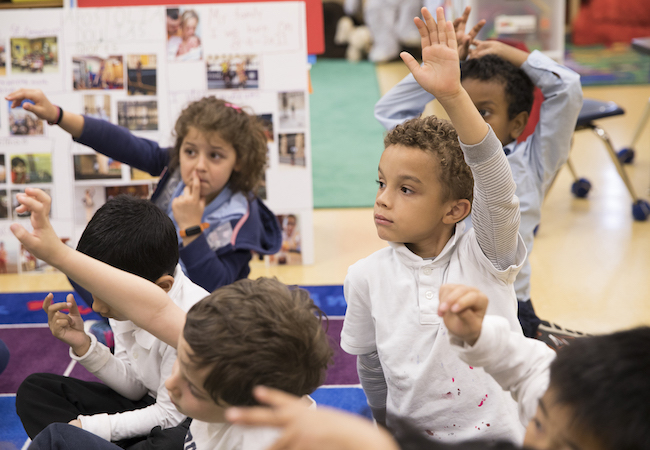Building social and emotional skills in young children
November 26, 2019
People often think of kindergarten as a place where students learn their ABCs and 123s. But it’s also a time when students gain social emotional learning skills. The skills that enable children to learn how to learn, and learn how to learn with others. These skills are essential for future academic achievement, healthy relationships, and career success.
Research has shown that behaviors like working independently, demonstrating consistent effort, and working and playing cooperatively are not just something kids pick up along the way. Families and educators must teach them.
In this issue of The Educator’s Playbook for Parents we’ll look at:
- The difference between We Skills and Me Skills
- Examples from home and school
- Tips parents can use to reinforce skill development
- Ideas for encouraging children in these areas
- Books that show the value of these skills
The Conquering Kindergarten toolkit — created in a partnership between the School District of Philadelphia, Penn GSE's John Fantuzzo and the Penn Child Research Center, and the Free Public Library of Philadelphia — is useful for families everywhere.
Thinking about the skills
Families can help children learn these skills when they understand what they are, why they are important, and how they can help children learn them. It can be helpful to think of these as Me Skills and We Skills. Me Skills, like completing work on time, are skills that help children manage themselves. We Skills, like handling conflict appropriately, are skills that help children manage interactions with other people.
We’ll take a look at one skill here, but you can explore all 14 in the Conquering Kindergarten toolkit.
A Me Skill: Demonstrates consistent effort
What is it?
This skill reflects a child’s ability to work through tasks toward a goal. That means handling frustration, staying focused, and not giving up. This skill is about sticking with something even when it is hard. This skill is important because it shows children that their effort matters and gives them confidence when they face challenges.
What does this same skill look like at home and at school?
At home: Laila is getting ready for school and wants to put on her own shoes. She puts her left shoe on her right foot. Her mom lets her know she made a mistake. Laila is not discouraged and tries again to put her shoes on but still struggles. Laila doesn’t give up and eventually gets it right.
In the classroom: Laila starts putting a puzzle together but can’t make some pieces fit. Instead of giving up, Laila tries a new way to put the pieces together. When one of her classmates tries to get her to play a game, she decides to stick with the puzzle instead.
What are some things I can do to help my child learn this skill?
Tip 1: Think like Goldilocks. In a children’s story, a little girl named Goldilocks tastes three bowls of food. One is “too hot,” one is “too cold,” and one is “just right.” For children to learn how to demonstrate consistent effort, they need tasks that are hard but not too hard to work on alone. If tasks are too challenging, children will get discouraged and be less likely to keep trying. If tasks are too easy, children will get bored and stop working. Try to give your child tasks that are “just right” for their ability level.
Want more advice on issues facing families?
Click here to subscribe to the Educator's Playbook for Parents newsletter
- How do you feel when you look at this?
- Does it make you feel good? Do you feel proud?
- We are going to hang this up on the wall. Are you happy with it or do you want to try again?
- Bring this into school to show your teacher how hard you worked. Are you excited about that?
If your child doesn’t feel proud and doesn’t want to share what they’ve done, ask them why. If they suggest that they can do better, encourage them to try again until they feel like they’ve done their best.
Tip 3: Show children how to talk their problems out. Learning to talk through problems is one way your child can learn how to keep trying. You can help your child learn this by showing them how you work through challenges. The next time you are struggling with something talk through it out loud. For example, while you are folding laundry, you might say: “I’m getting so angry! Folding this shirt is tricky. I want to give up, but I am not going to. OK, I’m going to take some deep breaths and try again.” When you try again, maybe mess up a few times and talk through the mistakes: “Hmm…that’s not right. Maybe, if I try this….” When you get it right, share how you feel: “I did it! I’m glad I didn’t give up.”
How can I encourage my child when I see them trying to learn this skill?
Acknowledge your child for their efforts! For example, tell your child, “Laila, look how hard you are working to read that book!” or “You really tried your best to put that puzzle together, Elijah!”
What children’s books show the value of the skill?
- Whistle for Wille, by Ezra Jack Keats
- Try and Stick with It, by Cheri Meiners
- The Very Clumsy Click Beatle, by Eric Carle
- The Little Engine That Could, by Watty Piper

More about Conquering Kindergarten
The School District of Philadelphia partnered with Penn GSE’s John Fantuzzo and the Penn Child Research Center to create within the District report card a scientifically valid measure of 14 of these important skills. This way, parents can understand how teachers are monitoring their children's progress, and be able to discuss it four times a year in parent-teacher conferences. This year, Penn GSE team partnered with parents and teachers to create Conquering Kindergarten, a special toolkit for parents and teachers that gives more helpful information about these 14 social emotional learning skills, and shows ways they can reinforce skill building at home and in school. Through a partnership with the Free Public Library of Philadelphia there are also recommendations of award-winning children’s books that showcase the main characters successfully using the skills.


